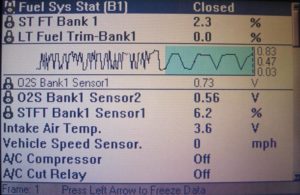Fuel Trim
What is fuel trim?
Modern automotive computers use fuel trim to vary the amount of fuel provided to the engine based on a FEEDBACK STRATEGY to accommodate wear and tear on the engine components and sensor degradation. In other words, the computer receives feedback information from many different sensors to inform the computer how good of a job it did in calculating how much fuel to add to the incoming air. The computer then adds or subtracts fuel during the next injection cycle and reviews the feedback data again, so the computer is constantly learning how well it did.
Learn more about fuel trim
What is long term fuel trim and how to diagnose a problem
What is adaptive memory and how to clear it
What is short term fuel trim?
Drivers are constantly changing the throttle and the vehicle

Scan tool fuel trim data
is constantly changing grade, so the computer is constantly playing a “catch up” game by incorporating feedback information from sensors. With each change, the computer modifies base fuel delivery by changing short term fuel trim (STFT).
What is long term fuel trim?
After a set period of time, the computer recognizes the pattern of adding or subtracting a certain amount of fuel based on the STFT values and move those values into long term fuel trim (LTFT) adaptive memory. In this same example, the computer will automatically add 5% more fuel to the engine, but will make minors adjustments to STFT based on feedback from the sensors.
When is fuel trim used?
Modern powertrain (PCM) and engine control computers (ECM) employ THREE distinct modes of operation: startup, open loop and closed loop.
STARTUP MODE
In startup mode the computer looks mainly at the engine coolant temperature (ECT) sensor and the engine RPM to determine how much fuel to add. Obviously, the ECT sensor tells the computer how cold or warm the engine is at startup. A cold engine tends to quench the combustion event, so more fuel is required for ignition and to maintain the “fire” long enough to provide the needed power. By following the engine RPM, the computer can compare the expected RPM versus actual RPM and make fuel adjustment.
Powertrain and engine control computers vary fuel delivery by pulsing the fuel injectors. The fuel rail is pressurized by the fuel pump, so the longer the fuel injector is open, the more fuel is delivers. In other words, the term “fuel injector” is actually a misnomer; it doesn’t actually inject fuel like a doctor’s syringe. Quite the opposite, it operates more like your kitchen faucet, opening and allowing well pump or city water pressure to push water through the facet. Leave the faucet open longer with a set amount of water pressure and you’ll get more water.
The concept of varying fuel injector pulse time is referred to as pulse width modulation (PWM). Each second is divided in to milliseconds. A cold start on a typical engine at 50°F may be as long as 90ms to provide enough fuel for startup. At this point, the computer is NOT reading feedback information from the camshaft (CMP), crankshaft (CKP), mass airflow (MAF), manifold absolute pressure (MAP), intake air temperature (IAT), throttle position (TPS) or oxygen sensors (O2).
OPEN LOOP MODE
The PCM or ECM enters open loop mode once the engine starts. It begins reading feedback from these sensors to vary fuel: ECT, CMP, CKP, MAF, MAP, TPS and IAT. Of all these sensor, data from the ECT carries the most weight, since engine temperature is most important in determining how much fuel to add. The faster the engine heats up, the faster the PCM/ECM can start reducing fuel.
As the engine nears operating temperature, the MAF/MAP and TPS play a more important role.
When does the PCM start reading the O2 sensors?
O2 sensors must heat up to a set temperature before they can provide and accurate feedback reading. Early O2 sensors depended on heat from the exhaust stream to raise the sensor temperature to the required level. Car makers then began adding electric heaters to the sensors to accelerate warm up time. The PCM/ECM will remain in OPEN LOOP until the O2 sensors reach operating temperature.
CLOSE LOOP MODE
Once the ECT reaches operating temperature and the O2 sensor(s) heats up and starts delivering reliable feedback reach operating temperature, the PCM/ECM shifts into closed loop mode. In closed loop mode, the PCM/ECM monitors all feedback sensors.
©, 2018 Rick Muscoplat
Posted on by Rick Muscoplat